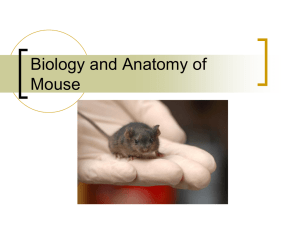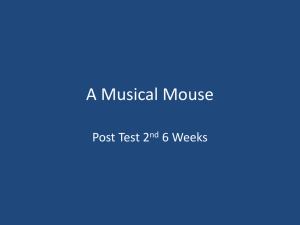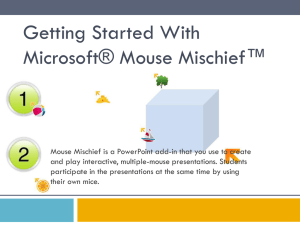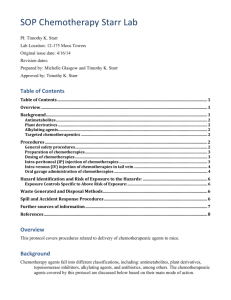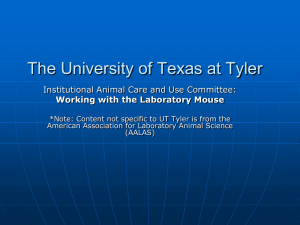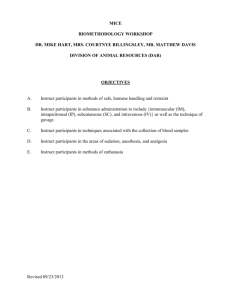The Laboratory Rat - The University of Tennessee College of
advertisement
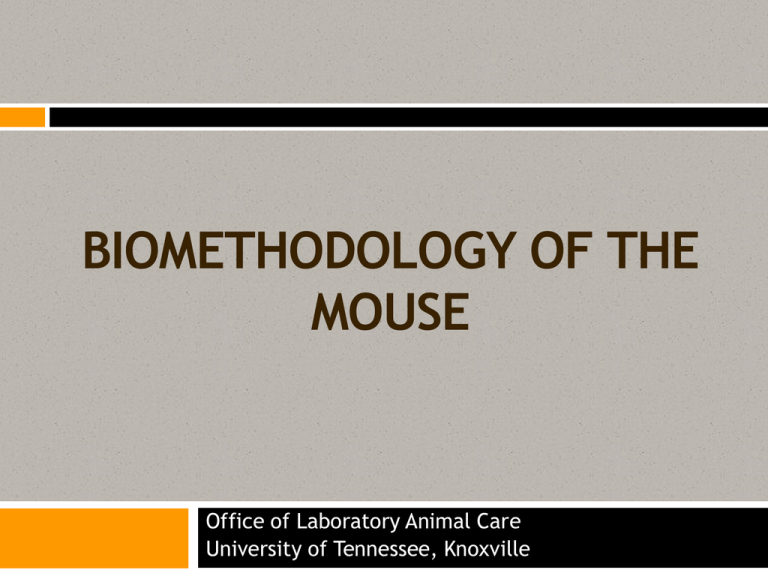
BIOMETHODOLOGY OF THE MOUSE Office of Laboratory Animal Care University of Tennessee, Knoxville General Behavior Nocturnal Non-aggressive towards humans Social Barbering is common Males are more likely to fight if housed with nonlittermates Weight Gain Chart C57BL/6 Reproduction Estrus Cycle 4–5 d Gestation 19-21 d Litter Size 10-12 pups Eyes open 14 d Weaning 21 d Postpartum estrus Reproductive life ~8 mo Sexing Newborns have a subtle difference in anogenital distance At 9 days of age, nipples are evident in the female and absent in the male Adults have a marked difference in anogenital distance Housing Adequate housing should provide the following: Clean, dry and safe area with adequate ventilation, food and water Visualization by personnel Sufficient space to turn around and make normal postural movements Enclosure Recommendations Primary enclosure space recommendations per the Guide for the Care and Use of Laboratory Animals Mice Weight (g) Floor Area (in2) Height (in) <10 6 5 Up to 15 8 5 Up to 25 12 5 >25 ≥15 5 UTK Mouse Cage Density Policy http://www.vet.utk.edu/olac/pdf/Mouse_Cage_Density_Policy.pdf Primary Enclosure Microisolator top Reduces spread of pathogens Wire-bar lid Water bottle Feed Cage Bottom Easy visualization Solid bottom flooring Bedding and enrichment Environmental Conditions Room Recommendations Temperature 68 – 79⁰F Humidity 30 -70% Ventilation 10 -15 air changes/hr. Noise ≥85 db can cause Stress Metabolic changes Reduced fertility Identification Ear Tags Ear Punches Identification Cage Card Procedures Institutional Animal Care and Use Committee (IACUC) protocol describes all procedures that can be performed A procedure is defined as any activity carried out on a mouse such as: Behavioral observation Venipuncture Surgery Manual Restraint Lift mouse by the base of the tail and place on wire bar lid Push the mouse against the wire bar to prevent escape and advance the hand toward the head. Grasp the scruff of the neck Tuck tail between finger and palm Manual Restraint Click to Watch Video Mechanical Restraint Decapicone Plastic Adjustable Restrainer Blood Collection Survival Procedures Orbital sinus Tail vein prick Facial vein Non-Survival Procedures Cardiac puncture Cranial vena cava puncture Axillary cut down Blood Collection Blood Collection Guidelines Single blood draw Multiple blood draws ≤1.0 ml per 100 grams of body weight Maximum of 1.5 ml per 100 grams of body weight within a 2 week period Note: Average mouse body weight is ~20 grams but can be highly variable between stock/strain Blood Collection Orbital sinus For collecting up to 0.2 ml of blood Anesthetize mouse Hold the head steady Insert pipette in the medial canthus of the eye Rotate the tube between thumb and finger Keeping eyelids closed, apply direct pressure using gauze for hemostasis Blood Collection Tail Nick For collecting up to 0.2 ml of blood Warm tail to dilate blood vessel Use proper restraint Prep with 70% alcohol Use #11 scalpel blade or needle to nick the lateral tail vein Apply direct pressure for hemostasis Blood Collection Facial Vein Hold the mouse securely Locate the puncture site slightly caudal to the freckle Apply petroleum based lubricant to the site Use a lancet or 18 gauge needle to puncture the skin Collect blood Apply direct pressure for hemostasis Blood Collection Cardiac For collecting up to 1.0 ml of blood Anesthetize mouse Insert ≤25 gauge needle under sternum at a 20⁰ angle Aspirate slowly Euthanize mouse Blood Collection Click to Watch Video Tissue Collection Tail Biopsy Limited to a maximum of 2 times Maximum of 5 mm Analgesia/Anesthesia is required for mice 21 days of age and older Compound Administration 25 to 27 gauge needle Maximum Administration Volumes (in ml/kg) IM 0.05-0.1 IP 10-80 IV (bolus) 5 PO SC (gastric gavage) 10-50 2-40 Compound Administration Subcutaneous (SC or SQ) The sides of the mouse serve as good site for SQ injections Insert needle underneath skin Aspirate negative pressure Inject compound and watch for SQ bleb To reduce leakage from the injection site, pause before retracting the needle Compound Administration Click to Watch Video Compound Administration Intraperitoneal (IP) Locate lower right quadrant for injection site Aspirate If an unintended subcutaneous bleb occurs, reposition the needle Compound Administration Click to Watch Video Compound Administration Intravenous (IV) Lateral tail vein Proper restraint Heat source to dilate vessel Apply direct pressure after injection Compound Administration Gastric Gavage (PO) Use a bulb-tipped gastric gavage needle Measure length of needle from mouth to last rib DO NOT FORCE the needle down the esophagus Inject solution Observe mouse for signs of distress Compound Administration Click to Watch Video Anesthesia When planning any procedure involving anesthesia and/or surgery, please consult one of the laboratory animal veterinarians in the Office of Laboratory Animal Care (OLAC) at 974-5634. The veterinarian can provide guidance and detailed information in selecting the most appropriate anesthetic and analgesic protocol for your mice and procedure. Aseptic Technique Surgical Prep After induction of anesthesia, clip hair from the surgical site Prep skin with povidone iodine, chlorhexidine or other appropriate skin antiseptic Scrub in a circular pattern, beginning in the center and spiraling outward Follow povidone iodine scrub with a 70% alcohol prep Repeat Twice End procedure with a light coat of povidone iodine solution (not scrub) to the surgical site Aseptic Technique Place a sterile drape over the mouse Anything that touches the surgical site must be sterile Non-absorbable sutures/clips should be removed in 7-14 days Surgical Monitoring Prevent pain, hypoxia, and hypothermia Monitor withdrawal reflex Provide a source of external heat Provide appropriate analgesics for postoperative pain management Record of Medical Care Record of Medical Care Euthanasia Inhalant Anesthetic Overdose Carbon Dioxide Isoflurane End the procedure with a thoracotomy or cervical dislocation Place mouse in the chamber Turn on CO2 flow into the chamber Once the mouse has stopped breathing, wait at least 1 minute before removing the mouse from the chamber End the procedure with a thoracotomy or cervical dislocation Substantially prolonged in neonates Cervical Dislocation Performed on anesthetized mice Must be performed by skilled personnel Occupational Health and Safety PPE (Personal Protective Equipment) Protects handler and mouse May include: gloves, gowns, lab coats, shoe covers, hair bonnets, face masks Prevention of Infectious Disease Colony Health Surveillance Sentinel mice detect for presence of infectious pathogens and parasites in the research colony Mouse Antibody Production Test (MAP Test) and PCR A test for cell lines and tumors for murine viruses Included in every animal use protocol Procurement of Mice APPROVED vendors include Charles River, Jackson Labs, Harlan, NCI-Frederick, and Taconic Mice that are shipped from a non-approved vendor source must be approved by OLAC before the mice are procured. An animal requisition form must be submitted to the facility manager: http://www.vet.utk.edu/olac/pdf/animal_acquisition_form.pdf Quarantine Quarantine is required if receiving mice from an unapproved vendor The minimum quarantine period is six (6) weeks No experimental manipulations or breeding can be initiated during the quarantine period unless approval has been granted by an OLAC veterinarian Health Concerns General appearance Lethargy Aggressiveness Hunched posture Coat Piloerection Hair loss Unkempt appearance Health Concerns Abnormal masses Skin lesions Health Concerns Teeth Normal Malocclusion Body Condition Scoring Ullman-Cullere, et al. 1999 Tumor Production Four criteria for euthanasia: Tumor size of 1.5 cm in diameter or tumor ulceration Body condition score of 1 Tumor interferes with function of vital organs Tumor significantly interferes with locomotion Reporting Signs of Pain or Distress For Mice That Require Veterinary Care Complete the red “Sick Animal” cage card Attach card to cage Notify facility manager or Print Clinical Case Request Form http://www.vet.utk.edu/olac/pdf/CLINICAL_CASE_REQUEST.pdf Fax form to the OLAC office 974-5649 Assessment of the mouse’s condition and treatments will be recorded on the “Sick Animal” card 10 Question Quiz References GUIDE FOR CARE AND USE OF LABORATORY ANIMALS. National Academy Press, 2011. Lawson, PT. 2005. ASSISTANT LABORATORY ANIMAL TECHNICIAN (ALAT) TRAINING MANUAL. The American Association for Laboratory Animal Science, Memphis, TN. Suckow M, Danneman P, Brayton C. 2001. THE LABORATORY MOUSE. CRC Press, Boca Raton, FL. Ullman-Cullere, M.H. and Foltz, C.J. 1999. Body Condition Scoring: A Rapid and Accurate Method for Assessing Health Status in Mice. Lab Anim Sci 49(3) 319-323. Presentation: Chris Carter, OLAC UTK
